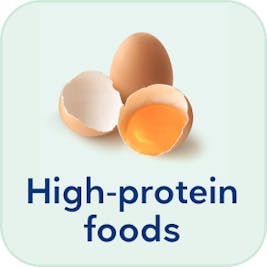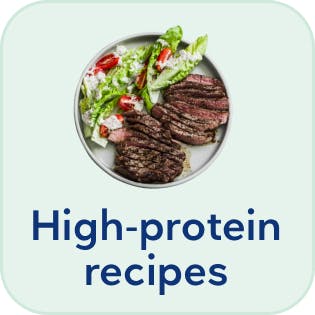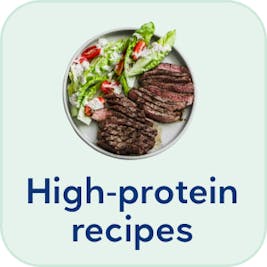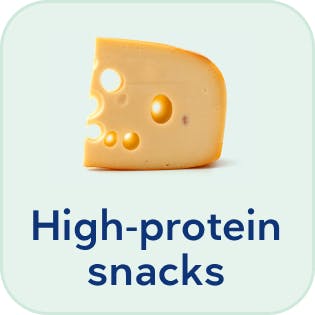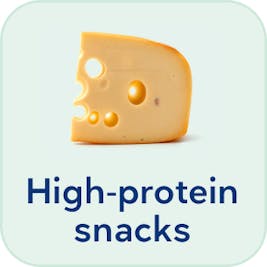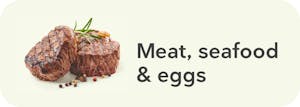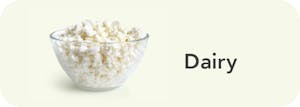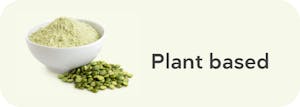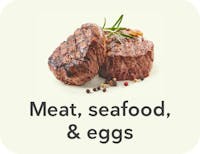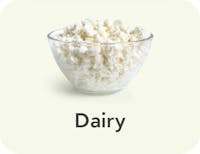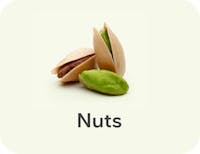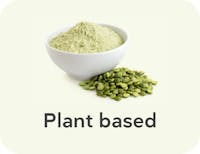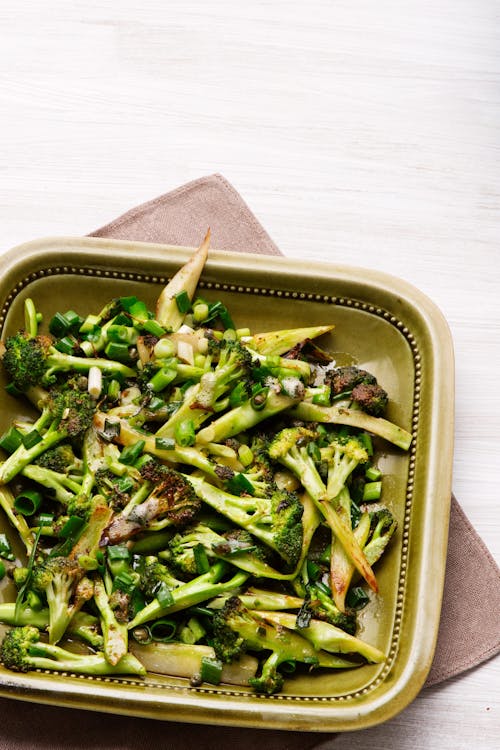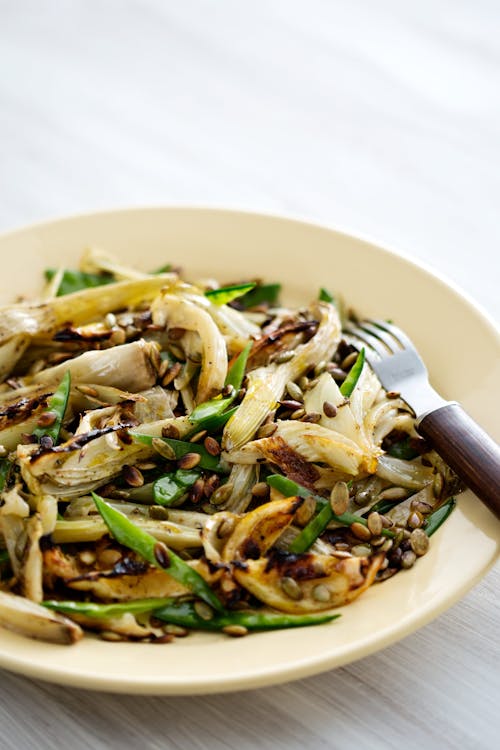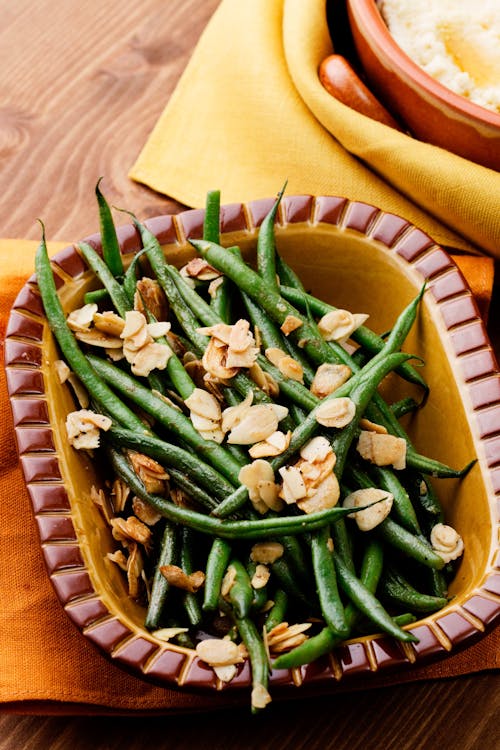The best high protein vegetables for weight loss
Can eating more vegetables help you lose weight? Absolutely! But some types are better for weight loss than others.
Your go-to vegetables should be the kinds that provide the most protein, nutrients, and fiber for the fewest calories. However, keep in mind that vegetables don’t provide much protein compared to meat, eggs, and other protein foods.
In this guide, we’ll share which high protein vegetables to prioritize, along with delicious recipes that feature them.
The top 10 high protein vegetables
- Spinach: 57% protein
- Bok choy: 56% protein
- Asparagus: 53% protein
- Mushrooms: 52% protein
- Collard greens: 45% protein
- Kale: 43% protein
- Arugula: 42% protein
- Romaine lettuce: 40% protein
- Turnip greens: 40% protein
- Brussels sprouts: 38% protein
Keep reading to learn more about the best high protein vegetables.
The image below shows the protein as a percentage of calories for different vegetables.The higher the number, the more protein the food provides per calorie.



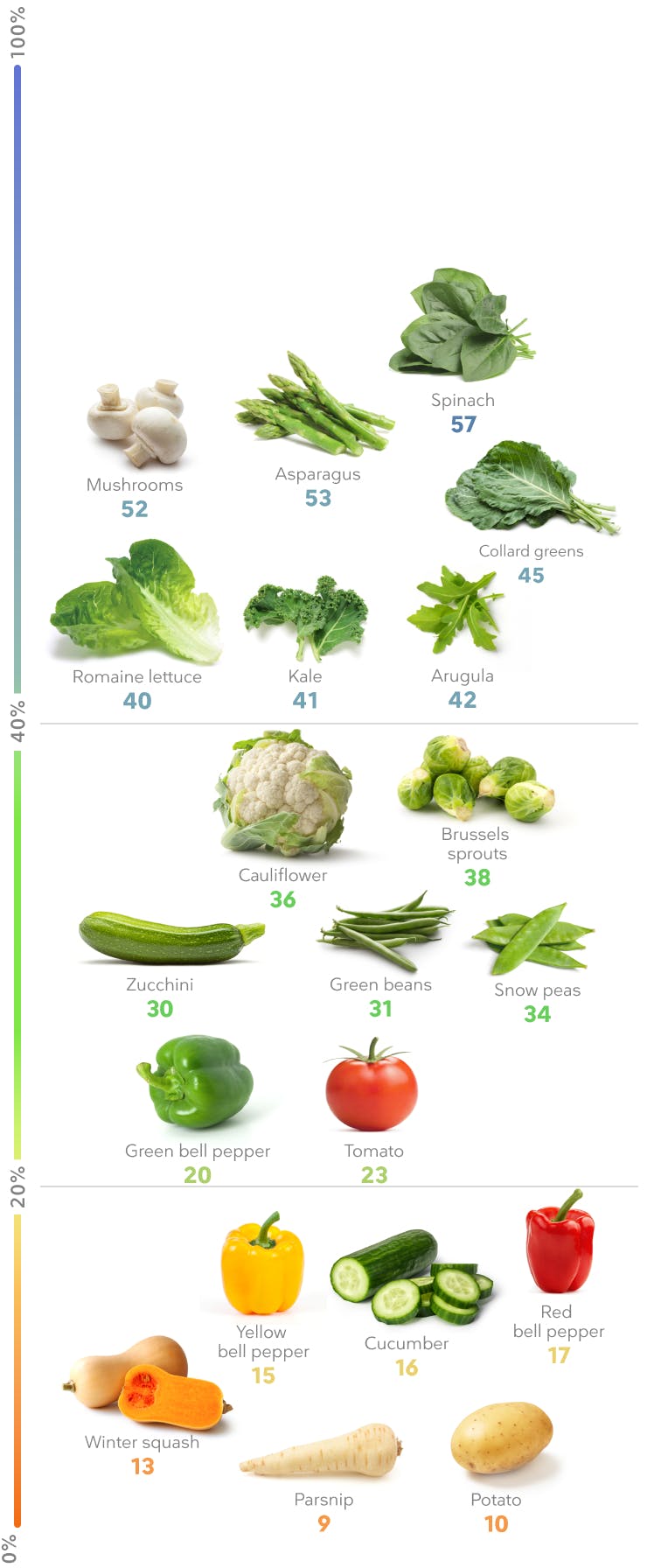


Key takeaways
Choose vegetables with a high protein percentage. Eat vegetables that provide the most protein per calorie, especially if you want to lose weight. Learn moreEat mostly non-starchy vegetables. Non-starchy vegetables are low in carbs. Many have high protein percentages, including spinach, asparagus, and mushrooms, among others. Learn more
Eat fewer starchy vegetables. Starchy vegetables are high in carbs and don’t provide much protein per calorie. This category includes carrots, beets, potatoes, and more. Learn more
More high protein guides
More high protein guides
Alternatively, watch a summary of this guide where we discuss three best tips for choosing the BEST high protein vegetables for healthy weight loss.
Selecting high protein vegetables
Eating high protein foods can help you feel full, lose weight, and prevent muscle loss.1
Yet, when you hear the term “high protein foods,” vegetables may not be the first thing that comes to mind.
Indeed, vegetables don’t provide a lot of protein compared to meat, eggs, beans, and some other foods. For instance, a 3.5-ounce (100-gram) serving of steak has about 25 to 30 grams of protein. Two large eggs (about 3.5 ounces) provide 13 grams of protein. By contrast, a 3.5-ounce serving of kale has only 3 grams of protein.
However, many vegetables have high protein percentages. This means that they provide a lot of protein per calorie.
A food’s protein percentage tells you how much of its calories, excluding fiber, come from protein.2
Vegetables with high protein percentages are low in both calories and net carbs. Many are high in fiber, which can help you feel full.3
Low carb vegetables are often the highest-protein vegetables. Why? Because most of the non-protein calories in vegetables typically come from carbs. Therefore, low carb vegetables usually contain more protein per calorie than higher carb vegetables.
So eat as much as you want of the vegetables with higher protein percentages. Yes, they’re unlimited, and we encourage you to consume a wide variety of them!
However, don’t prepare a giant green salad, roast a head of cauliflower, or cook a big pot of green beans and call it dinner. Vegetables have so much fiber and water that you’ll get full long before you meet your protein needs. They’re also low in at least one of the essential amino acids (the building blocks of protein) that your body requires to stay healthy.4
So make sure to eat plenty of foods from our meat, dairy, and plant-based protein guides, in addition to vegetables.
How much protein do you need? To optimize satiety and healthy weight loss, we recommend aiming to eat at least 100 grams of protein per day if you’re a woman and 140 grams if you’re a man of average height and build. Eat more if you’re a man taller than 6 feet (183 cm) or a woman taller than 5 feet 6 inches (168 cm) or if you’re very physically active. Eat less if you’re shorter or have a petite frame.
In this guide, we provide both the protein percentages and gram amounts per serving for vegetables.5 These are based on average values. The protein percentages and gram amounts can vary slightly depending on growing conditions, type of plant, and preparation.
Non-starchy vegetables
(mostly above-ground)




These vegetables usually provide more protein per calorie than starchy vegetables that grow below the ground. Therefore, their protein percentages are relatively high. But remember, these vegetables don’t provide much protein compared to meat, fish, eggs, tofu, and similar foods.
Among the highest-protein vegetables are spinach and other greens, asparagus, and mushrooms.
But if you prefer zucchini, cabbage, cauliflower, or other vegetables, you can still enjoy those favorites. You don’t need to stick with the top five on the list. In short, what are the best non-starchy vegetables to eat? The ones you like the most.
Besides protein, vegetables contain vitamin C, vitamin A (from beta-carotene), potassium, and other vitamins and minerals, depending on the type.7
Below are the protein percentages and gram amounts of protein, fiber, and net carbs per 3.5-ounce (100-gram) serving of vegetables.
- Spinach
Protein percentage: 57%
3 grams of protein, 2.4 grams of fiber, and 1.4 grams of net carbs per serving
One serving is approximately 1/2 cup of cooked spinach (or 3 cups of raw spinach). - Bok choy
Protein percentage: 56%
1.5 grams of protein, 1 gram of fiber, and 0.8 grams of net carbs per serving
One serving is approximately 1/2 cup of cooked bok choy (or 1 1/3 cups of chopped, raw bok choy). - Asparagus
Protein percentage: 53%
2.4 grams of protein, 2 grams of fiber, and 2 grams of net carbs per serving
One serving is approximately 3/4 cup of cooked asparagus. - Mushrooms
Protein percentage: 52%
3 grams of protein, 1 gram of fiber, and 2 grams of net carbs per serving
One serving is approximately 1 cup of sliced, cooked mushrooms (or 1 1/2 cups of sliced, raw mushrooms). - Collard greens
Protein percentage: 45%
2.7 grams of protein, 4 grams of fiber, and 1.7 grams of net carbs per serving
One serving is approximately 1/2 cup of cooked collard greens (or 3 cups of chopped, raw collard greens). - Kale
Protein percentage: 43%
3 grams of protein, 2 grams of fiber, and 3 grams of net carbs per serving
One serving is approximately 1 cup of cooked kale (or 2 cups of raw kale). - Arugula
Protein percentage: 42%
2.6 grams of protein,1.5 grams of fiber, and 2 grams of net carbs per serving
One serving is approximately 5 cups of raw arugula. - Turnip greens
Protein percentage: 40%
1 gram of protein, 3.5 grams of fiber, and 1 gram of net carbs per serving
One serving is approximately 2/3 cup of cooked turnip greens (or 2 cups of chopped, raw turnip greens). - Romaine lettuce
Protein percentage: 40%
1.2 grams of protein, 2 grams of fiber, and 1 gram of net carbs per serving
One serving is approximately 2 cups of shredded lettuce. - Cabbage
Protein percentage: 38%
1.8 grams of protein, 2.8 grams of fiber, and 3 grams of net carbs per serving
One serving is approximately 2/3 cup of cooked cabbage (or 1 1/2 cups of shredded, raw cabbage). - Brussels sprouts
Protein percentage: 38%
3.4 grams of protein, 4 grams of fiber, and 5 grams of net carbs per serving
One serving is approximately 1 cup of cooked Brussels sprouts. - Broccoli
Protein percentage: 36%
2.8 grams of protein, 2.6 grams of fiber, and 4 grams of net carbs per serving
One serving is approximately 1 cup of chopped broccoli (cooked or raw). - Cauliflower
Protein percentage: 36%
2 grams of protein, 2 grams of fiber, and 3 grams of net carbs per serving
One serving is approximately 1 cup of chopped cauliflower (cooked or raw). - Snap peas and snow peas8
Protein percentage: 34%
2.8 grams of protein, 2.5 grams of fiber, and 5 grams of net carbs per serving
One serving is approximately 2/3 cup of cooked snap peas or snow peas. - Green beans
Protein percentage: 31%
1.8 grams of protein, 3 grams of fiber, and 4 grams of net carbs per serving
One serving is approximately 1 cup of cooked green beans. - Artichoke
Protein percentage: 30%
3 grams of protein, 6 grams of fiber, and 6 grams of net carbs per serving
One serving is approximately 1 medium cooked artichoke. - Zucchini
Protein percentage: 30%
1.2 grams of protein, 1 gram of fiber, and 2 grams of net carbs per serving
One serving is approximately 1/2 cup of sliced, cooked zucchini (or 1 cup of sliced, raw zucchini). - Celery
Protein percentage: 28%
0.7 grams of protein, 1.5 grams of fiber, and 1.5 grams of net carbs per serving
One serving is approximately 1 cup of chopped, raw celery. - Iceberg lettuce
Protein percentage: 28%
0.9 grams of protein, 1 gram of fiber, and 2 grams of net carbs per serving
One serving is approximately 1 1/3 cups of shredded lettuce. - Rhubarb
Protein percentage: 23%
0.9 grams of protein, 1.8 grams of fiber, and 2.7 grams of net carbs per serving
One serving is approximately 1 cup of cooked rhubarb. - Radishes
Protein percentage: 23%
0.7 grams of protein, 1.6 grams of fiber, and 2 grams of net carbs per serving
One serving is approximately 1 cup of chopped, raw radishes. - Tomato
Protein percentage: 23%
0.9 grams of protein, 1 gram of fiber, and 2.7 grams of net carbs per serving
One serving is approximately 1/2 cup of chopped raw tomatoes (or 6 cherry tomatoes). - Eggplant
Protein percentage: 22%
1 gram of protein, 3 grams of fiber, and 3 grams of net carbs per serving
One serving is approximately 1 cup of chopped, cooked eggplant. - Green bell pepper
Protein percentage: 20%
0.9 grams of protein, 2 grams of fiber, and 3 grams of net carbs per serving
One serving is approximately 2/3 cup of chopped raw or cooked bell pepper. - Turnip
Protein percentage: 19%
0.7 grams of protein, 2 grams of fiber, and 3 grams of net carbs per serving
One serving is approximately 1/2 cup of mashed, cooked turnips. - Cucumber
Protein percentage: 18%
0.7 grams of protein, 0.5 grams of fiber, and 3.1 grams of net carbs per serving
One serving is approximately 1 cup of sliced, raw cucumber. - Red bell pepper
Protein percentage: 17%
1 gram of protein, 2 grams of fiber, and 4 grams of net carbs per serving
One serving is approximately 2/3 cup of chopped raw or cooked bell pepper. - Yellow bell pepper
Protein percentage: 15%
1 gram of protein, 1 gram of fiber, and 5 grams of net carbs per serving
One serving is approximately 2/3 cup of chopped raw or cooked bell pepper.
Starchy vegetables
(mostly below-ground)




These vegetables are low in fat and contain many of the same vitamins and minerals found in non-starchy vegetables. Some are also relatively high in fiber, such as carrots and sweet potatoes. However, their protein percentages are generally lower than non-starchy vegetables because they are higher in carbs.
If you want to lose weight or control your blood sugar, you’re best off eating only small amounts of starchy vegetables and sticking mainly with non-starchy types as part of a low carb diet.9
Below are the protein percentages and gram amounts of protein, fiber, and net carbs per 3.5-ounce (100-gram) serving of vegetables.
- Beets (beetroot)
Protein percentage: 17%
1.7 grams of protein, 2 grams of fiber, and 8 grams of net carbs per serving
One serving is approximately 2 medium cooked beets or 1 cup of chopped, cooked beets. - Rutabaga
Protein percentage: 14%
0.9 grams of protein, 1.8 grams of fiber, and 6 grams of net carbs per serving
One serving is approximately 1/2 cup of mashed, cooked rutabaga. - Winter squash
Protein percentage: 13% (average)
1 gram of protein, 3 grams of fiber, and 6 grams of net carbs per serving10 One serving is approximately 1/2 cup of chopped, cooked squash. - Carrot
Protein percentage: 12%
1 gram of protein, 2.8 grams of fiber, and 7 grams of net carbs per serving
One serving is approximately 2/3 cup of sliced, cooked carrots (or 1 cup of grated raw carrots). - Onion
Protein percentage: 11%
1 gram of protein, 1.5 grams of fiber, and 8 grams of net carbs per serving
One serving is approximately 1/2 cup of chopped, cooked onion (or 2/3 cup of chopped raw onion). - Sweet potato
Protein percentage: 10%
2 grams of protein, 3.5 grams of fiber, and 17 grams of net carbs per serving
One serving is approximately 1/2 cup of mashed, cooked sweet potatoes. - White potato
Protein percentage: 10%
2 grams of protein, 2 grams of fiber, and 19 grams of net carbs per serving
One serving is approximately half of a medium potato, 2/3 cup of diced potatoes, or 1/2 cup of mashed potatoes. - Parsnip
Protein percentage: 9%
1.3 grams of protein, 4 grams of fiber, and 13 grams of net carbs per serving
One serving is approximately 2/3 cup of sliced, cooked parsnips.
Vegetable side-dish recipes
Pairing high protein vegetables with a bit of butter, oil, or a creamy sauce makes them taste delicious. Check out some of our most popular vegetable side dishes to include at your meals:
Start your FREE 30-day trial!
Get instant access to healthy low carb and keto meal plans, fast and easy recipes, weight loss advice from medical experts, and so much more. A healthier life starts now with your free trial!
Start FREE trial!
Learn more about protein
Systematic reviews of randomized trials — considered the strongest evidence — have repeatedly demonstrated this:
Nutrition Reviews 2021: Dose–response relationship between protein intake and muscle mass increase: a systematic review and meta-analysis of randomized controlled trials [systematic review of randomized trials; strong evidence]
Journal of the American College of Nutrition 2004: The effects of high protein diets on thermogenesis, satiety and weight loss: a critical review [systematic review of randomized trials; strong evidence]
Nutrition Reviews 2016: Effects of dietary protein intake on body composition changes after weight loss in older adults: a systematic review and meta-analysis [systematic review of randomized trials; strong evidence]
The Journal of Nutrition 2013: Normal protein intake is required for body weight loss and weight maintenance, and elevated protein intake for additional preservation of resting energy expenditure and fat free mass [randomized trial; moderate evidence] ↩
Fiber isn’t included in the calorie count because it’s generally accepted that humans don’t produce the enzymes needed to break down fiber:
Gut Microbes 2017: Dietary fiber and prebiotics and the gastrointestinal microbiota [overview article; ungraded]
Instead, fiber passes through your system until it reaches your colon, where it is either fermented by bacteria or eliminated, depending on the type:
International Journal of Molecular Sciences 2017: Gut fermentation of dietary fibres: physico-chemistry of plant cell walls and implications for health [overview article; ungraded] ↩
In one study, people who ate a large portion of spinach at lunch felt significantly fuller than when they ate a calorie-matched meal without spinach. The researchers attributed the increased satiety to the high fiber and water content of the meal that contained spinach:
International Journal of Food Sciences and Nutrition 1995: Satiety effects of spinach in mixed meals: comparison with other vegetables [non-controlled study; weak evidence] ↩
There are nine essential amino acids that you must get from food on a daily basis. Although most vegetables contain many of these essential amino acids, they provide only small amounts of one or more of them.
In one study, researchers found that spinach contained all nine essential amino acids, although methionine was only present in small amounts:Food Chemistry 2011: Amino acid profile of raw and as-eaten products of spinach (Spinacia oleracea L.) [laboratory study; ungraded]
In an older study, cauliflower was found to be high in five of the nine essential amino acids, while carrots were found to be low in all of the essential amino acids:
The Journal of Nutrition 1949: The essential amino acid content of several vegetables [laboratory study; ungraded] ↩
We obtained nutrition information from FoodData Central, the USDA’s nutrient profile database. ↩
Radishes and turnips are root vegetables, and white asparagus, leeks, fennel bulbs, and a few other non-starchy vegetables have earth covering them in the cultivation process to keep them white and tender. ↩
Vitamin A, or retinol, is only found in animal foods. Your body converts beta-carotene from plants into vitamin A. ↩
Although their taste and texture differ slightly, snap peas and snow peas have identical nutrition profiles. ↩
Low carb diets have been found effective for weight loss and diabetes control in several systematic reviews of randomized trials:
Obesity Reviews 2016: Impact of low carbohydrate diet on body composition: meta-analysis of randomized controlled studies [strong evidence]
PLoS One 2015: Dietary intervention for overweight and obese adults: Comparison of low carbohydrate and low fat diets. A meta-analysis [strong evidence]
Diabetes Research and Clinical Practice 2017: Efficacy of low carbohydrate diet for type 2 diabetes mellitus management: A systematic review and meta-analysis of randomized controlled trials [strong evidence] ↩
Although protein content is similar among different squash types, protein percentages and carb contents vary. Pumpkin has the highest protein percentage at 17% and contains the fewest net carbs at 5 grams per serving. Acorn squash has the lowest protein percentage at 10% and is highest in net carbs at 10 grams per serving. ↩




